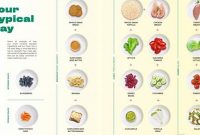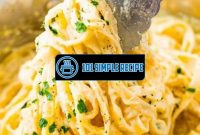Looking for delicious and healthy meal ideas that are gluten-free? Look no further! In this article, we will provide you with a variety of mouthwatering dinner recipes that are not only free from gluten but also packed with flavor and nutrients. Whether you follow a gluten-free diet due to health reasons or are simply looking to incorporate more wholesome meals into your routine, these ideas will surely satisfy your taste buds and leave you feeling nourished and satisfied. So, get ready to explore a world of delectable gluten-free dinner options that will make your taste buds dance with joy! ️

Understanding Gluten-Free Diets
Gluten-free diets have become increasingly popular in recent years, especially among individuals with gluten sensitivities or celiac disease. These diets eliminate gluten, a protein found in wheat, barley, and rye. By following a gluten-free diet, individuals can alleviate symptoms such as bloating, diarrhea, and abdominal pain. In this section, we will explore the basics of gluten-free diets and their benefits for those with gluten sensitivities or celiac disease.
What is Gluten?
Gluten is a protein commonly found in grains such as wheat, barley, and rye. It gives bread and other baked goods their elasticity and chewy texture. However, for individuals with gluten sensitivities or celiac disease, consuming gluten can trigger an immune response in the body. This immune response can damage the lining of the small intestine, leading to various health issues.
To better understand the impact of gluten, imagine a rubber band. Gluten acts as the “glue” that holds together the dough, making it stretchy and giving it structure. When someone with a gluten sensitivity or celiac disease consumes gluten, the immune system recognizes it as an invader and unleashes an inflammatory response. This inflammation can cause a range of symptoms, from mild digestive discomfort to severe intestinal damage.
Who Should Follow a Gluten-Free Diet?
A gluten-free diet is essential for individuals with celiac disease, an autoimmune disorder that affects about 1% of the population. In these individuals, consuming gluten can damage the small intestine and impair nutrient absorption, leading to malnutrition and long-term health complications. For those with gluten sensitivities or non-celiac gluten sensitivity, adopting a gluten-free diet can significantly improve their quality of life by reducing uncomfortable symptoms.
It’s important to note that not everyone needs to follow a gluten-free diet. Individuals without gluten sensitivities or celiac disease can consume gluten without any adverse effects. In fact, eliminating gluten from your diet unnecessarily may lead to nutrient deficiencies, as gluten-containing grains are often enriched with essential vitamins and minerals.
Health Benefits of a Gluten-Free Diet
For individuals with gluten sensitivities or celiac disease, following a gluten-free diet can have numerous health benefits. By eliminating gluten from their diet, they can experience significant improvements in digestion, overall wellbeing, and quality of life. Some of the main health benefits of a gluten-free diet include:
- Improved Digestion: Removing gluten from the diet can alleviate symptoms such as bloating, gas, diarrhea, and abdominal pain. This can lead to improved digestion and increased comfort after meals.
- Inflammation Reduction: Gluten can trigger inflammation in individuals with gluten sensitivities or celiac disease. By eliminating gluten, inflammation levels can decrease, leading to reduced oxidative stress and a lower risk of chronic diseases.
- Increased Nutrient Absorption: Individuals with celiac disease often have impaired nutrient absorption due to damage to the small intestine. By eliminating gluten, the intestinal lining can heal, allowing for better absorption of vital nutrients.
- Weight Management: Adopting a gluten-free diet can aid in weight management, as gluten-containing foods are often high in calories and carbohydrates. By replacing these foods with healthier alternatives, individuals can achieve a better balance in their overall diet.
In conclusion, understanding gluten-free diets and their benefits is crucial for individuals with gluten sensitivities or celiac disease. By eliminating gluten from their diet, they can alleviate symptoms, improve digestion, reduce inflammation, enhance nutrient absorption, and manage weight more effectively. However, it’s important to remember that a gluten-free diet is not necessary for everyone and may lead to nutrient deficiencies if followed unnecessarily.
If you’re looking for gluten-free dinner ideas, you might want to try this White Castle recipe. It’s a delicious option that’s suitable for those who are gluten intolerant.
Finding Gluten-Free Ingredients
When it comes to finding gluten-free ingredients, there are a few key strategies you can follow to ensure you meet your dietary needs. Whether you have Celiac disease or are simply choosing to follow a gluten-free lifestyle, it’s important to know where to find the right ingredients to create delicious and nutritious meals.
Gluten-Free Labels and Certifications
One way to identify gluten-free ingredients is by looking for specific labels and certifications. When shopping for groceries, keep an eye out for products that are labeled as “gluten-free” or that bear a gluten-free certification. This ensures that the product has undergone testing and meets the necessary requirements to be considered safe for consumption by those with gluten sensitivities or allergies. You can trust these labels to guide you in choosing the right ingredients for your gluten-free dinner.
It’s also important to note that different countries may have different certifications or standards for gluten-free products. For example, in the United States, the Food and Drug Administration (FDA) has established a standard for gluten-free labeling, which requires that products labeled as such contain less than 20 parts per million (ppm) of gluten. Familiarize yourself with the specific certifications and standards in your country to ensure you’re making informed choices.
Common Gluten-Free Substitutes
Another way to find gluten-free ingredients is by exploring common substitutes for gluten-containing foods. There are several alternatives available that can replace traditional wheat-based products in your meals. For example, instead of using regular flour, you can opt for gluten-free flours such as almond flour, coconut flour, or rice flour. These substitutes not only add a unique flavor profile to your dishes but also provide the necessary texture and structure.
Other common gluten-free substitutes include using gluten-free pastas made from rice, quinoa, or chickpea flour. These alternative pastas are widely available and can be used in your favorite pasta dishes without compromising on taste or texture. Similarly, there are gluten-free bread options made from ingredients like tapioca, potato, or sorghum flour.
Reading Food Labels and Identifying Hidden Sources of Gluten
One of the most important skills you can develop as someone following a gluten-free diet is the ability to read food labels and identify hidden sources of gluten. While many products may seem gluten-free at first glance, they may contain hidden ingredients that can trigger a reaction.
When examining food labels, look for ingredients such as wheat, barley, rye, and malt, as these are common sources of gluten. However, it’s essential to note that some products may hide gluten under different names, such as modified food starch or hydrolyzed vegetable protein. By familiarizing yourself with these hidden sources, you can make informed decisions when selecting ingredients for your gluten-free dinner.
Additionally, cross-contamination can be a concern when it comes to gluten-free ingredients. Make sure to read labels carefully and look for statements indicating that the product was manufactured in a gluten-free facility or on equipment that is also used for gluten-free products. This way, you can ensure that the ingredients you choose are safe for your dietary needs.
By following these strategies and remaining vigilant in your ingredient choices, you can create delicious gluten-free meals that cater to your dietary needs. Whether you’re experimenting in the kitchen or dining out, knowing where to find gluten-free ingredients and how to identify them will allow you to enjoy a healthy and satisfying dinner.
For a healthier option, you can check out this weight loss recipe. It’s gluten-free and can be a great addition to your dinner ideas.
Gluten-Free Dinner Ideas
When it comes to gluten-free dinner ideas, the possibilities are vast, and you don’t have to compromise on taste or variety. Whether you follow a gluten-free diet due to dietary restrictions or simply want to try something new, these dinner ideas are sure to inspire you. From vegetarian options to quick and simple meals for busy weeknights, and even recipes for special occasions, there’s something for everyone to enjoy.
Vegetarian Gluten-Free Dinner Options
For those following a vegetarian and gluten-free diet, there are plenty of delicious dinner options to choose from. One idea is a hearty vegetable stir-fry, packed with colorful veggies like bell peppers, broccoli, and carrots. You can serve it over gluten-free rice noodles or quinoa for a filling and nutritious meal. Another option is a flavorful cauliflower curry, made with fragrant spices like turmeric, cumin, and coriander. Serve it with gluten-free naan bread or basmati rice for a delightful and satisfying dinner.
Try a vegetable stir-fry with gluten-free noodles or quinoa.
Enjoy a flavorful cauliflower curry with gluten-free naan or rice.
Quick and Simple Gluten-Free Dinners for Busy Weeknights
We all have those evenings when we’re short on time but still want to enjoy a delicious gluten-free dinner. Luckily, there are plenty of quick and simple recipes to choose from. One idea is a zucchini noodle pasta, made with spiralized zucchini instead of traditional pasta. Top it with your favorite gluten-free marinara sauce and a sprinkle of Parmesan cheese for a satisfying and low-carb meal. Another option is a grilled chicken salad, packed with fresh greens, grilled chicken breast, and your favorite gluten-free dressing. It’s a light yet flavorful option for those busy weeknights.
⏱️ Whip up a quick and easy zucchini noodle pasta with gluten-free marinara sauce.
⏱️ Enjoy a refreshing grilled chicken salad with your favorite gluten-free dressing.
Gluten-Free Dinner Recipes for Special Occasions
When it comes to special occasions, it’s always nice to have a standout gluten-free dinner recipe. One option is a mouthwatering grilled salmon with lemon-dill sauce. The salmon is seasoned with herbs and spices, then grilled to perfection and topped with a tangy lemon-dill sauce. Serve it with a side of roasted potatoes and steamed vegetables for an elegant and gluten-free meal. Another impressive recipe is a stuffed bell pepper dish, filled with a flavorful mixture of quinoa, black beans, corn, and spices. Top it with melted cheese and bake until the peppers are tender and the cheese is bubbly.
Impress your guests with grilled salmon topped with lemon-dill sauce.
Delight in stuffed bell peppers filled with a savory quinoa and black bean mixture.
With these gluten-free dinner ideas, you’ll never feel limited in your choices. From vegetarian options to quick and simple meals for busy nights, and even recipes for special occasions, there’s something to suit every taste and dietary restriction. Get creative in the kitchen, experiment with different flavors and ingredients, and enjoy a delicious gluten-free meal tonight!
Tips for Cooking Gluten-Free
Gluten-free cooking can be a challenge, but with the right tips and tricks, you can create delicious and safe meals that everyone can enjoy. Whether you have a gluten intolerance or simply want to try a gluten-free diet, these tips will help you navigate the world of gluten-free cooking with ease.
- First and foremost, it’s important to understand what gluten is and what foods contain it. Gluten is a protein found in wheat, barley, and rye. Avoiding these ingredients is crucial when cooking gluten-free meals.
- When it comes to cooking gluten-free, it’s important to stay organized. Create a designated gluten-free area in your kitchen and label all your gluten-free ingredients to prevent cross-contamination.
- Experiment with gluten-free flours and binders to find the ones that work best for your recipes. There are many options available, such as almond flour, rice flour, and tapioca starch.
- When cooking gluten-free, it’s important to read labels carefully. Look out for hidden sources of gluten, such as soy sauce, salad dressings, and seasonings. Opt for certified gluten-free products whenever possible.
- Using fresh and natural ingredients is key to creating flavorful gluten-free meals. Opt for whole foods like fruits, vegetables, lean meats, and seafood to ensure a nutritious and delicious meal.
- Don’t be afraid to get creative with your recipes. There are plenty of gluten-free alternatives for traditional dishes, such as cauliflower rice instead of regular rice or zucchini noodles instead of wheat-based pasta.
- Lastly, don’t forget to enjoy the process of cooking gluten-free. Embrace the challenge and discover new flavors and textures that you may not have explored before. And remember, practice makes perfect!
In conclusion, cooking gluten-free meals can be a rewarding experience with the right tips and tricks. By understanding what gluten is, staying organized, experimenting with gluten-free flours, reading labels, using fresh ingredients, getting creative, and embracing the process, you can create delicious and safe gluten-free meals that will satisfy your taste buds. So go ahead, give it a try and enjoy the benefits of a gluten-free lifestyle!
Gluten-Free Baking Tips
Baking gluten-free can be a bit more challenging than regular baking, but with these helpful tips, you’ll be able to whip up gluten-free treats that are just as delicious.
- Start by stocking up on gluten-free baking essentials. This includes gluten-free flour blends, xanthan gum (a binder), and baking powder and soda.
- Measure your ingredients carefully when baking gluten-free. Use a scale for accuracy, as gluten-free flours can have different weights and absorbency levels.
- Experiment with different gluten-free flours to achieve the right texture and taste in your baked goods. Consider using a blend of flours for the best results.
- Include a binder, such as xanthan gum or psyllium husk, in your gluten-free recipes to help mimic the structure and elasticity that gluten provides.
- Don’t overmix your batter when baking gluten-free. Overmixing can lead to a denser and tougher end result. Mix until just combined.
- Give your gluten-free baked goods some extra time to cool and set. They may be a bit more fragile and crumbly when fresh out of the oven.
- Consider adding extra moisture to your gluten-free recipes. This can be done by using ingredients like applesauce, yogurt, or coconut oil.
So there you have it, some essential gluten-free baking tips to help you create tasty treats without the gluten. With a little practice and experimentation, you’ll be a pro at gluten-free baking in no time!
How to Prevent Cross-Contamination in the Kitchen
Cross-contamination occurs when gluten-containing products come into contact with gluten-free ones, leading to the risk of exposure for those with gluten sensitivities or celiac disease. Follow these tips to prevent cross-contamination in your kitchen and ensure the safety of your gluten-free meals.
- Create a designated gluten-free area in your kitchen. This can be a separate countertop, cutting board, or even a dedicated shelf in your pantry.
- Label all your gluten-free ingredients and utensils to avoid confusion. This will help remind you and others in your household to only use them for gluten-free cooking.
- Keep your gluten-free ingredients stored in sealed containers to prevent cross-contamination from airborne flour particles.
- Invest in separate cooking utensils, such as knives, spatulas, and baking sheets, for gluten-free cooking. This will reduce the risk of cross-contamination.
- Clean your kitchen thoroughly and regularly to eliminate any gluten residue. Pay extra attention to commonly used surfaces, such as countertops, stovetops, and oven racks.
- When cooking gluten-free meals, cook them first before preparing any gluten-containing dishes. This will minimize the risk of cross-contamination.
- Be cautious when dining out or ordering takeout. Always communicate your dietary needs to the restaurant staff and ask about their practices to prevent cross-contamination.
By following these steps, you can create a gluten-free-friendly kitchen environment and minimize the risk of cross-contamination. This will help ensure the safety and enjoyment of your gluten-free meals.
Using Gluten-Free Flours and Binders
Gluten-free flours and binders are essential ingredients when cooking gluten-free. They help provide structure, texture, and flavor to your dishes. Here are some popular gluten-free flours and binders to consider using in your recipes.
- Almond flour is a versatile and nutrient-dense flour made from ground almonds. It adds a delicious nutty flavor and works well in baked goods, crusts, and coatings.
- Rice flour is a common gluten-free flour made from ground rice. It has a mild flavor and a fine texture, making it suitable for a variety of recipes.
- Tapioca starch is extracted from the cassava plant and is often used as a thickening agent. It adds a chewy texture to recipes and can be used in baking and as a binder in sauces and soups.
- Coconut flour is made from dried and ground coconut meat. It has a distinct coconut flavor and absorbs a lot of moisture, so it’s important to use it in combination with other flours.
- When it comes to binders, xanthan gum is commonly used in gluten-free baking. It helps mimic the elasticity of gluten and provides structure to baked goods.
- Psyllium husk is another popular binder that can be used in gluten-free recipes. It helps with moisture retention and can be used in bread and other baked goods.
- Chia seeds and flaxseeds can also be used as binders in gluten-free cooking. When combined with water, they create a gel-like consistency that can replace eggs in some recipes.
These are just a few examples of gluten-free flours and binders you can experiment with in your gluten-free cooking. Don’t be afraid to try different combinations and find the ones that work best for your recipes. Happy cooking!
Gluten-Free Dining Out
Navigate the world of dining out while following a gluten-free diet, including how to communicate your needs to restaurant staff.
Researching Gluten-Free-Friendly Restaurants
When it comes to dining out on a gluten-free diet, it’s crucial to do your research beforehand. Thankfully, more and more restaurants are catering to gluten-sensitive individuals. To find gluten-free-friendly restaurants in your area, start by utilizing online platforms and apps that specialize in restaurant recommendations. These platforms often allow users to filter their search based on dietary restrictions, including gluten-free options.
Emoji:
Additionally, you can reach out to local support groups or gluten-free communities for recommendations. These groups often have firsthand experience with different dining establishments and can provide valuable insight into their gluten-free offerings.
Communicating with Restaurant Staff
Once you’ve identified a potential gluten-free-friendly restaurant, it’s important to communicate your specific dietary needs to the staff. Before visiting the restaurant, consider calling ahead to inquire about their gluten-free options. This not only allows you to gauge their knowledge and understanding of gluten-free diets but also gives them an opportunity to prepare in advance.
Emoji:
When speaking with the restaurant staff, be clear and specific about your dietary requirements. Let them know about your gluten sensitivity or intolerance and ask about the precautions they take to prevent cross-contamination in the kitchen. Inquiring about their gluten-free cooking methods and ingredient sourcing can help you ensure that the meal will be truly safe for consumption.
During your conversation, take note of how receptive and accommodating the staff is toward your needs. A restaurant that prioritizes customer satisfaction and understands the importance of catering to dietary restrictions is more likely to provide a positive dining experience.
Avoiding Cross-Contamination in Restaurants
When dining out on a gluten-free diet, the risk of cross-contamination cannot be overlooked. Even well-intentioned restaurants may unknowingly expose your food to gluten during preparation or serving.
Emoji: ⚠️
To minimize the risk of cross-contamination, consider the following strategies:
- Inform the waiter or server about your dietary needs as soon as you arrive at the restaurant. This will allow them to take necessary precautions and alert the kitchen staff.
- Ask for guidance and recommendations from the staff regarding gluten-free menu items or modifications that can be made to accommodate your needs.
- Request separate utensils, cutting boards, and preparation areas to avoid contact with gluten-containing ingredients.
- Suggest using fresh, uncontaminated oil or grill surfaces for cooking your meal.
- Emoji: ️Consider bringing your own gluten-free condiments, such as soy sauce or salad dressings, to ensure they are safe for consumption.
By taking these extra precautions and effectively communicating your needs, you can enjoy a delicious and worry-free gluten-free dining experience.
Another option to consider is this punch bowl recipe. It’s gluten-free and can add some refreshing flavors to your dinner menu.
Thanks for reading our article on dinner ideas gluten free! We hope you found some delicious and nutritious meal inspiration. Don’t forget to bookmark our page and visit again later for more gluten-free dinner ideas. We strive to provide a variety of recipes that cater to different dietary needs, so you’ll always find something that suits your taste! Whether you’re looking for quick and easy weeknight meals or indulgent weekend dinners, we’ve got you covered. Stay tuned for more mouthwatering recipes!
Frequently Asked Questions
Here are some commonly asked questions about gluten-free dinner ideas:
| No. | Questions | Answers |
|---|---|---|
| 1. | Are all the dinner ideas in this article suitable for people with gluten intolerance? | Yes, all the dinner ideas in this article are gluten-free and suitable for people with gluten intolerance. You can enjoy these meals without worrying about any gluten-related health issues. Bon appétit! |
| 2. | Can I substitute gluten-containing ingredients with gluten-free alternatives? | Absolutely! Many gluten-containing ingredients can be easily substituted with gluten-free alternatives. For example, you can use gluten-free pasta instead of regular pasta or almond flour instead of wheat flour. Just be sure to check the labels of your ingredients and follow the recipe instructions accordingly. |
| 3. | Do these dinner ideas require any special kitchen equipment? | No, these dinner ideas can be prepared with basic kitchen equipment that you likely already have. A good set of knives, pots and pans, a cutting board, and a stove or oven are all you need to create delicious gluten-free meals. |
| 4. | Are there any gluten-free dessert ideas included in this article? | While this article focuses on gluten-free dinner ideas, we do have a separate article dedicated to gluten-free desserts. You can find a wide range of gluten-free dessert recipes on our website to satisfy your sweet tooth. |
| 5. | Where can I find gluten-free ingredients? | Gluten-free ingredients can be found in most grocery stores, especially in the health food or special dietary needs sections. Additionally, many online retailers offer a wide variety of gluten-free ingredients, making it convenient to shop from the comfort of your own home. |
| 6. | Can I freeze gluten-free meals for later use? | Yes, you can freeze gluten-free meals for later use. Just make sure to store them in airtight containers or freezer bags to maintain their freshness. It’s a great way to have pre-made gluten-free meals ready to enjoy whenever you need them. |
Closing Thoughts
We hope these gluten-free dinner ideas have sparked your creativity in the kitchen! Remember, there are endless possibilities when it comes to gluten-free cooking, and we’re here to provide you with delicious recipes that cater to your dietary needs. Don’t hesitate to explore our website for more inspiration and culinary adventures. Thanks again for reading, and we look forward to sharing more gluten-free goodness with you in the future. Happy cooking!
Jump to Recipe
Gluten-Free Dinner Ideas

Discover a wide range of delicious and gluten-free dinner ideas that will satisfy your taste buds and dietary needs.
- 2 cups gluten-free pasta
- 1 pound chicken breast (cut into strips)
- 1 red bell pepper (sliced)
- 1 zucchini (sliced)
- 1 tablespoon olive oil
- 1 teaspoon garlic powder
- 1 teaspoon paprika
- Salt and pepper to taste
- Cook the gluten-free pasta according to the instructions on the package. Drain and set aside.
- In a large skillet, heat the olive oil over medium heat. Add the chicken strips and cook until browned and cooked through.
- Add the sliced bell pepper and zucchini to the skillet. Cook until the vegetables are tender.
- Season the chicken and vegetables with garlic powder, paprika, salt, and pepper. Stir well to evenly coat everything.
- Add the cooked pasta to the skillet and toss everything together until well combined.
- Serve the gluten-free chicken and vegetable pasta hot, and enjoy!






